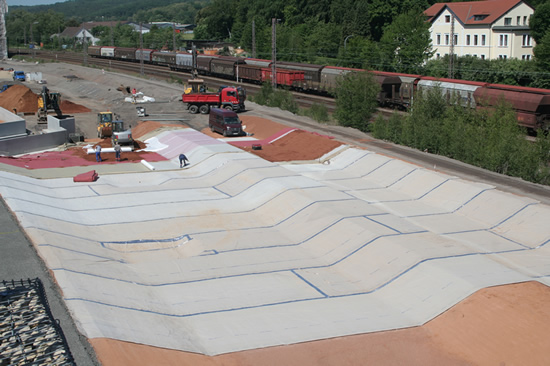
During the June 2012 ASTM meeting of Committee D35 on Geosynthetics, a special symposium was held on “Current and Future Practices for the Testing of Multi-Component Geosynthetic Clay Liners.” This marked the third GCL symposia the committee had conducted, with the first two taking place in 1996 and 2003. Here in 2013, the book from that gathering has been published in print and digital formats.
Geosynthetic clay liners (GCLs) have certainly been a steadily innovated materials group. Their composite structure has enabled them to benefit from advances in their components and how their components are joined, which in turn impacts how the overall GCL can perform. The breadth of applications has expanded. The strength of performance has increased. The economic and sustainability benefits have become clearer.
The most recent symposium addressed this deeply, with 15 papers from an international group of practitioners who have been at the heart of GCL advances in manufacturing, design, and installation: Chris Athanassopoulos, Bruno Herlin, George Koerner, Nathalie Touze-Foltz, Thomas Egloffstein, and many others. The volume has been edited by Kent von Maubeuge and JP Kline.
In the overview, the editors summarize perfectly the challenge at hand:
These material advancements have continued to extend the suitability and survivability of geosynthetic clay liners in a variety of containment designs; but they have also complicated standardization in ways that could inhibit market growth and acceptance if the changes too greatly outpace the standards community’s ability to provide guidance and leadership within the larger geotechnical engineering field.
Current and Future Practices for the Testing of Multi-Component Geosynthetic Clay Liners stands as an important contribution to the field’s understanding of the evolution and future path of GCL usage in environmental protection and barrier systems.
Table of Contents
- Multi-Component Geosynthetic Clay Liners: A Product With New Possibilities
— Egloffstein T., Ehrenberg H., Kalsow J., von Maubeuge K. - Hydraulic Testing of Multi-Component Geosynthetic Clay Liners
— Ehrenberg H., von Maubeuge K. - Flow Rate Measurement in Multi-Component Geosynthetic Clay Liners
— Barral C., Croissant D., Touze-Foltz N., von Maubeuge K. - Water-Vapor Diffusion Through Polymeric Barriers Used in Multi-Component GCLs
— Allen S. - Interface Transmissivity Measurement in Multicomponent Geosynthetic Clay Liners
— Bannour H., Courté A., Touze-Foltz N., von Maubeuge K. - Large-Scale Flow Testing through Seamed and Unseamed Samples of a Multi-Component Geosynthetic Clay Liner
— Athanassopoulos C., Goldenberg M., Trauger R., Yuan Z. - Peel Testing and Moisture Effects for Coated/Laminated Geosynthetic Clay Liners
— Torosian G. - Peel and Shear Test Comparison and Geosynthetic Clay Liner Shear Strength Correlation
— Ehrenberg H., von Maubeuge K. - Direct Shear Testing Performed on Multi-Component GCLs With Laminated/Coated Side
— Kline J., Youngblood J. - Boundary Effects of Gripping System on Internal Shear Strength Tests of Multi-Component Geosynthetic Clay Liners
— Tang X., Yuan Z. - Cyclic Shear Testing of a Multi-Component Geosynthetic Clay Liner
— Athanassopoulos C., Fox P., Goldenberg M., Ross J. - Abrasion Testing on Multi-Component Geosynthetic Clay Liners
— Herlin B., Kennedy B. - Factors Influencing Dimensional Stability of Multi-Component Geosynthetic Clay Liners
— Hanson J., Olsen G., Yesiller N. - Calcium Carbonate Content of Various Bentonites Used in GCLs
— Koerner G. - The Geosynthetic Concrete Composite Mat (GCCM)
— Kohlman R., Paulson J.
**
Visit Committee D35 online at http://www.astm.org/COMMITTEE/D35.htm.












